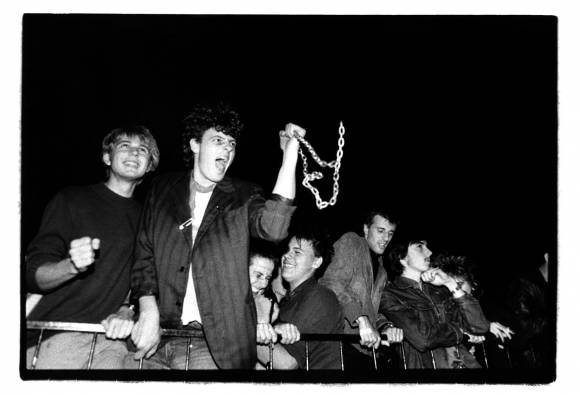
Slovenian Punk & Photography
Janez Bogataj, Božidar Dolenc, Vojko Flegar, Dušan Gerlica, Siniša Lopojda, Elena Pečarič, Matija Praznik, Bogo Pretnar, Bojan Radovič, Relations / 25 years of the lesbian group ŠKUC-LL, Mladen Romih, Tone Stojko, Jože Suhadolnik, Jane Štravs, Tožibabe, Igor Vidmar
Slovenian Punk & Photography is a comprehensive exhibition that connects photography with various aspects of the Slovenian punk movement from 1977 to the mid-1980s, as well as the periods before and after punk. The exhibition also encompasses subcultural and alternative events in Ljubljana during the 1980s, including a focus on the emergence of the LGBT+ community in the 1980s, with groups like Laibach and other bold and subversive activities.
The exhibition provides insight into the important role of photography in documenting and being a vehicle for the expression of the Slovenian punk movement and other subcultural events of that time.
Slovenian punk contributed to the creation of a bold and provocative photographic aesthetic that is still recognizable and influential today. Punk left its mark not only on music but also on art, fashion, and lifestyle. Photography became essential for expressing the punk spirit, conveying messages about social and political issues, and creating visual imagery that reflected the spirit of the time. It became a means through which artists and scene members expressed their dissatisfaction with the political and social situation and brought alternative perspectives to the world. The photographs depict provocation and resistance to conventional norms. In many cases, photographs of the punk subculture focused on events at concerts, street protests, and alternative venues where punks gathered. These photographic images convey energy, chaos, and defiance of traditional values. Punk enthusiasts were captured in wild, eccentric, and challenging poses with distinct fashion stylings that showcased their directness, anarchism, and resistance against social norms.
Photographs of the punk subculture have become an important part of the movement's archive. They spread the messages of punks and shaped the iconography and image of the subculture. They were often published in punk fanzines, on posters, album covers, and other promotional materials. Together with music, fashion, and art, photography in the punk subculture served as a medium for expressing resistance, critiquing society, and building community. Punk induced changes in the photographic practice and encouraged creativity as members of the Slovenian punk and alternative scene self-archived and documented their own movement through photography.
Although Ljubljana occupied a central place in urban punk life, and the photographs record images of venues as legendary as Kavarna Union, Študentsko naselje (student residence halls), Galerija ŠKUC, Disko FV, the railway station, Rio, Filozofska fakulteta (Faculty of Arts), and Fakulteta za družbene vede (Faculty of Social Sciences), the exhibition also presents events on the periphery, in Novo mesto, Idrija, Škofja Loka, and beyond the borders of Slovenia. The Slovenian punk scene was known for its independence and criticism of the political system and social norms of the time. However, it was also a pro-socialist, working-class, youth-oriented, and rebellious attitude in response to social injustice, political apathy, and economic crisis. This energy also became instrumental in transforming Slovenian photography itself.
The exhibition creates a network of visual references and stories that enable a contemporary performative representation of narratives of resistance and rebellion. With this exhibition, we aim to highlight resistance as a political category with a politics of the body that opposes the body of politics. Workers' protests were an important part of the political and social movement of that time. They emerged as a response to the exploitation of the working class, poor working conditions, inequality, and other social problems. Punk bands supported these protests and often accompanied them with their music, lyrics, and performances.
To this day, punk culture and workers' protests intertwine in the fight for justice, equality, and societal change. Punk remains a voice of resistance against injustice, exploitation, and political apathy. Therefore, it is not surprising that punk elements often appear in contemporary workers' protests, which advocate for workers' rights, social security, and systemic changes. This is also evident in the protests in Slovenia during the Covid-19 pandemic from 2020 to 2022.
During this period, numerous protests took place, addressing various aspects of government measures and responses to the pandemic. Photography played a significant role in documenting and preserving the memory of these events, as well as showcasing the diversity and unity of the protesters. Alongside other activists, members of the punk subculture demonstrated their active political engagement and resistance against specific political decisions and measures, thus continuing the tradition of rebellion and expressing dissatisfaction characteristic of the punk subculture.
Marina Gržinić
About the authors
Janez Bogataj has gone down in the history of Slovenian photography as a documentarist of the socio-politically turbulent 1980s.
Božidar Dolenc (1950–2008) was one of the most prominent Slovenian photographers of the second half of the 20th century.
Vojko Flegar is a lawyer, retired journalist, contributor to Radio Študent and Tribuna, correspondent, commentator and editor of Delo and Dnevnik, as well as a freelance journalist and editor of the web portal razgledi.net.
Dušan Gerlica photographed concert scenes of the most important punk positions at the beginning of punk and at the end of Yugoslav social realism.
Siniša Lopojda is one of the central figures of the alternative and subcultural scene in Ljubljana that developed in 1980s around the ŠKUC Gallery and Disco FV.
Elena Pečarič is a philosopher, cultural sociologist and activist.
Matija Praznik, an electrical engineering graduate with a four-year degree in philosophy, was an active supporter of Ljubljana’s alternative scene in the early 1980s.
Bogo Pretnar, the guitarist of the band Pankrti and their indefatigable “archivist,” keeps an extensive documentation of the Pankrti’s history.
Bojan Radovič is a co-founder of the photo gallery Pri Slonu, the Photo Gallery Novo Mesto and founder of Luminus Ltd. and the House of Photography.
RELATIONS / 25 YEARS OF THE LESBIAN GROUP ŠKUC-LL deals with the 25th anniversary of the lesbian group ŠKUC-LL (1987–2012) and with the lesbian movement in the former Yugoslavia.
Mladen Romih regularly accompanied events at the university with his camera in the 1980s, focusing on student life.
Tone Stojko worked for RTV Ljubljana and was a member of Fotogrupa ŠOLT while studying journalism in Ljubljana. In the 1980s he systematically captured the democratisation and formation of the Slovenian state.
Jože Suhadolnik began his photographic journey in 1982 in Disco FV in Rožna dolina. He documented the emerging punk and new wave scene of the 1980s.
Jane Štravs began exhibiting in the early 1980s as one of the most prominent chroniclers and protagonists of Ljubljana’s alternative cultural scene.
Tožibabe, formed in the early 1980s, are one of the first Slovenian hardcore/punk bands and the first Slovenian and Yugoslav all-female band in which women are not only singers but also authors of music, lyrics and arrangements.
Igor Vidmar, known as the godfather of Slovenian punk, was a key figure in the alternative music scene in Slovenia and the former Yugoslavia in the 1980s.
Realisation of the exhibition
Marina Gržinić (curator of the exhibition and realisation of the exhibition project) is a principal research associate at the Institute of Philosophy ZRC SAZU and a full professor at the Academy of Fine Arts Vienna.
Jovita Pristovšek (realisation of the exhibition project) is a research assistant at the Institute of Culture and Memory Studies ZRC SAZU.
Metod Prijatelj (architect of the exhibition) is a conceptual architect and constructor.
Admission
Admission: EUR 6 /person
Discounted tickets: EUR 4 /person (*visitors aged under 25, over 65 and pensioners)
Free admission: children aged under 12, holders of a EU Disability Card, holders of valid museum cards
We recommend that children under the age of 12 are accompanied by a parent or guardian.
Public guided tours: admission fee, NO extra charge
School visits (10 persons or more):
Admission: EUR 3 /person
Guided tour of the exhibition: admission + EUR 20 (tour surcharge)
Groups of adults (10 persons or more):
Guided tour of the exhibition: admission + EUR 20 (tour surcharge)
Catalogue: EUR 15
Slovenian Punk & Photography
6,00 EUR
4,00 EUR * * EUR for younger than 25 and older than 65, as well as pensioners
The reduced admission fee for the CD Gallery exhibitions (marked with the asterisk*) applies to visitors aged under 25 and over 65, retirees and disabled persons. Free admission: pre-school children, accompanying persons of persons with disabilities, tou
Kustosinja razstave: Marina Gržinić
Realizacija projekta razstave: Marina Gržinić, Jovita Pristovšek
Arhitekt razstave: Metod Prijatelj


Bodite med prvimi ...
.... ki boste izvedeli, katere koncerte, predavanja, gledališka in plesna gostovanja in drugo pripravljamo v Cankarjevem domu,





















